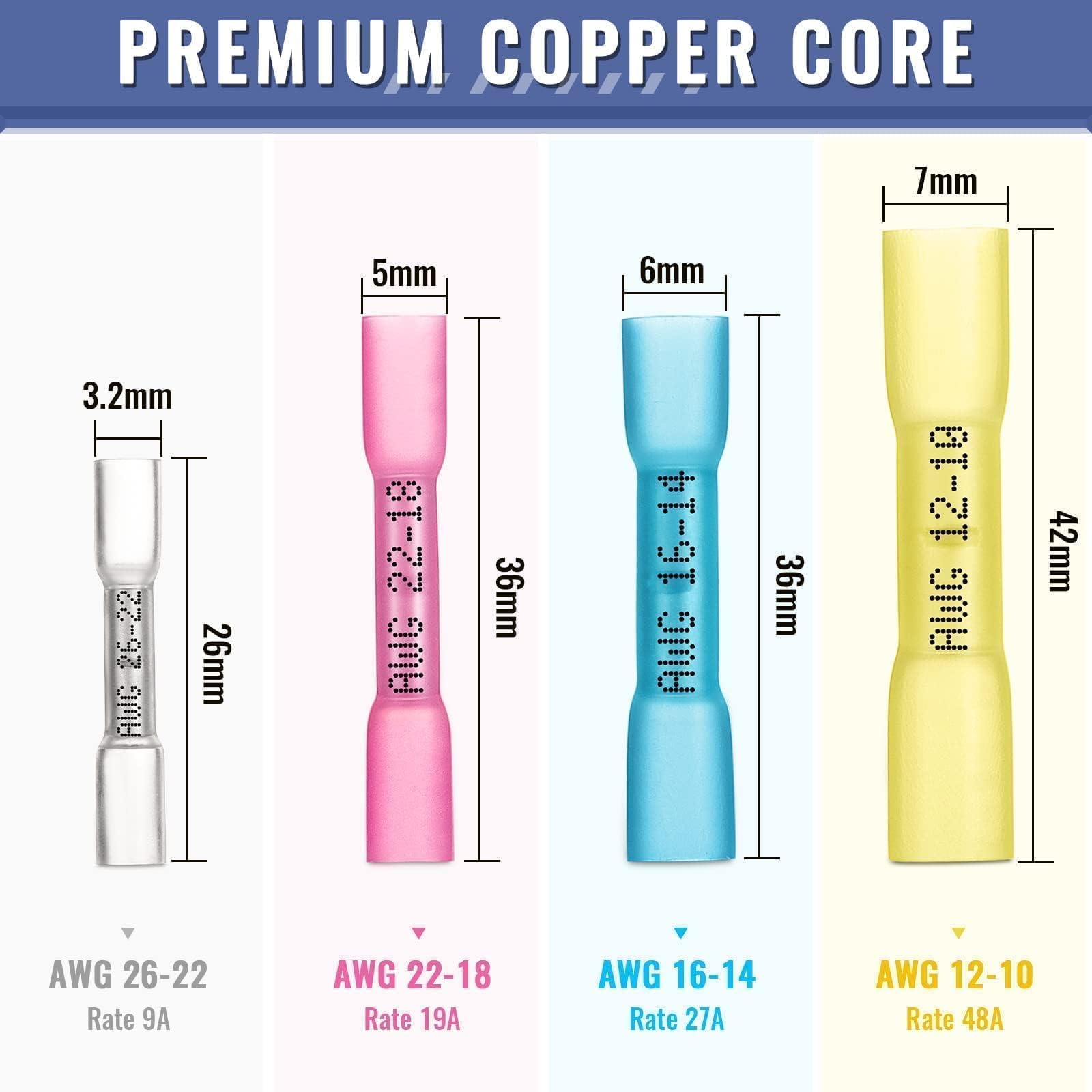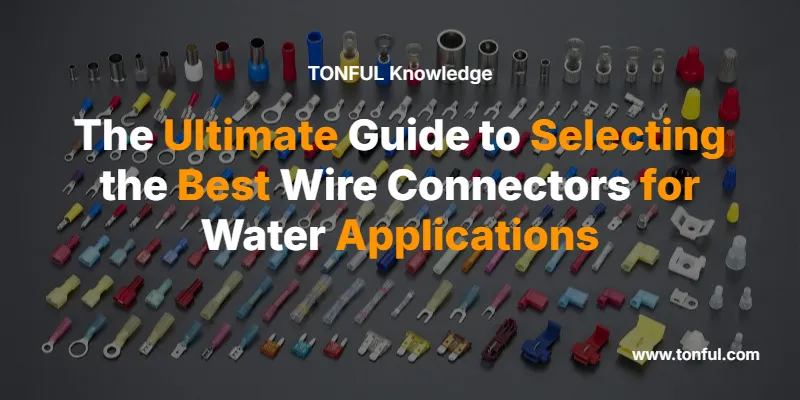Understanding the right wire connector for water applications is critical for electrical safety, system reliability, and code compliance. This comprehensive guide covers everything you need to make the best choice for your project while prioritizing safety and performance.
What Are Water-Resistant Wire Connectors?

Water-resistant wire connectors are specialized electrical joining devices designed to maintain secure electrical connections while preventing moisture ingress that could cause short circuits, corrosion, or electrical hazards. These connectors use advanced sealing technologies, protective coatings, and engineered materials to withstand various levels of water exposure.
Key Protection Features:
- Sealed housing with gaskets or O-rings
- Waterproof cable entry points
- Corrosion-resistant materials (stainless steel, marine-grade plastics)
- IP (Ingress Protection) ratings indicating water resistance levels
- UV-resistant outer coatings for outdoor applications
Essential Water Protection Ratings and Standards
| Rating Standard | Protection Level | Water Resistance | Best Applications |
|---|---|---|---|
| IP65 | Dust-tight, Water Jets | Protected against water jets from any direction | Outdoor lighting, pool equipment |
| IP67 | Dust-tight, Temporary Immersion | Submersible up to 1 meter for 30 minutes | Garden lighting, pond pumps |
| IP68 | Dust-tight, Continuous Immersion | Submersible beyond 1 meter indefinitely | Underwater lighting, marine electronics |
| NEMA 4 | Weather-resistant | Rain, snow, windblown dust | Outdoor electrical boxes |
| NEMA 4X | Corrosion-resistant | Same as NEMA 4 plus corrosion protection | Marine, chemical environments |
| NEMA 6P | Submersible | Temporary submersion, ice formation | Flood-prone areas, washdown applications |
⚠️ Safety Warning: Never assume a connector is waterproof without verifying its IP or NEMA rating. Using inadequate protection in water applications can result in electrical shock, fire, or equipment damage.
Types of Wire Connectors for Water Applications
1. Waterproof Junction Boxes
Best for: Permanent installations requiring multiple wire connections
Key Features:
- Multiple cable entry points with sealed glands
- Internal terminal blocks or wire nuts
- IP65 to IP68 ratings available
- UV-resistant housings
Applications: Pool equipment, outdoor lighting systems, irrigation controls
2. Heat Shrink Connectors with Adhesive Liner

Best for: Individual wire splices in wet environments
Key Features:
- Dual-wall construction with adhesive inner layer
- Heat-activated seal creates waterproof barrier
- Marine-grade materials resist salt corrosion
- Temperature range: -55°F to 221°F (-48°C to 105°C)
Applications: Marine wiring, automotive applications, outdoor sensors
3. Submersible Wire Splice Connectors
Best for: Direct burial or underwater applications
Key Features:
- Silicone gel-filled chambers
- No heat or tools required for installation
- Reusable in many designs
- Compatible with various wire gauges
Applications: Pond lighting, well pumps, underground installations
4. Twist-On Wire Connectors (Waterproof)
Best for: Quick connections in damp conditions
Key Features:
- Silicone-sealed interior chambers
- Color-coded for different wire gauges
- Twist-on installation similar to standard wire nuts
- IP65 rating when properly installed
Applications: Bathroom fans, outdoor fixtures, basement wiring
Comprehensive Connector Comparison Table
| Connector Type | IP Rating | Installation Method | Wire Gauge Range | Cost Level | Reusability | Best Use Case |
|---|---|---|---|---|---|---|
| Waterproof Junction Box | IP65-IP68 | Screw terminals | 12-4 AWG | $$$ | Yes | Multiple connections |
| Heat Shrink Adhesive | IP67 | Heat gun required | 22-10 AWG | $$ | No | Individual splices |
| Submersible Splice | IP68 | Hand assembly | 18-12 AWG | $$$ | Sometimes | Underwater/buried |
| Waterproof Wire Nuts | IP65 | Twist-on | 22-12 AWG | $ | No | Quick repairs |
| Marine Terminal Blocks | IP67 | Screw connection | 16-4 AWG | $$$$ | Yes | Marine installations |
Step-by-Step Selection Process
Step 1: Determine Your Water Exposure Level
Assess your installation environment:
- Damp conditions: Occasional moisture, high humidity (IP65 minimum)
- Wet conditions: Direct water contact, rain exposure (IP67 minimum)
- Submersible conditions: Temporary or permanent underwater (IP68 required)
Step 2: Check Code Requirements
Verify compliance with relevant standards:
- NEC Article 110.14: Connection requirements for conductors
- NEC Article 300.5: Underground installations
- NEC Article 680: Swimming pools and similar installations
- Local building codes may have additional requirements
💡 Expert Tip: Always consult local electrical codes and consider hiring a licensed electrician for complex installations involving water and electricity.
Step 3: Calculate Electrical Requirements
Determine your specifications:
- Voltage rating: Must exceed your system voltage
- Current capacity: Should handle 125% of expected load
- Wire gauge compatibility: Match your existing wiring
- Temperature rating: Consider ambient and operating temperatures
Step 4: Consider Environmental Factors
Evaluate additional challenges:
- UV exposure: Requires UV-resistant materials
- Chemical exposure: May need NEMA 4X rating
- Temperature extremes: Check operating temperature ranges
- Physical stress: Consider strain relief requirements
Installation Best Practices and Safety Guidelines
Proper Installation Techniques
- Prepare Wires Correctly
- Strip insulation to manufacturer specifications
- Clean copper conductors to remove oxidation
- Ensure wire ends are straight and uniform
- Apply Sealants Properly
- Use electrical-grade silicone sealant only
- Allow full cure time before exposure to moisture
- Apply sealant to all threaded connections
- Test Before Final Installation
- Use multimeter to verify continuity
- Perform insulation resistance test
- Check for proper ground fault protection
⚠️ Critical Safety Warning: All water-related electrical work must be protected by GFCI (Ground Fault Circuit Interrupter) devices as required by electrical codes. Failure to include GFCI protection can result in fatal electrical shock.
Common Installation Mistakes to Avoid
- Insufficient wire stripping: Creates poor connections and potential failure points
- Overtightening connections: Can damage connector seals or wire insulation
- Mixing connector types: Different materials may cause galvanic corrosion
- Ignoring temperature ratings: Extreme temperatures can cause seal failure
- Skipping strain relief: Physical stress can compromise waterproof seals
Troubleshooting Water Connector Issues
Problem: Corrosion at Connection Points
Symptoms: Green or white buildup on connections, increased resistance
Solutions:
- Replace with marine-grade connectors
- Apply dielectric grease to connections
- Ensure proper drainage from enclosures
- Check for dissimilar metal connections
Problem: Intermittent Connection Loss
Symptoms: Flickering lights, sporadic equipment operation
Solutions:
- Check for loose connections due to thermal cycling
- Verify proper wire gauge for current load
- Inspect for water infiltration causing oxidation
- Consider upgrading to higher-rated connectors
Problem: Complete Connection Failure
Symptoms: No electrical continuity, equipment not functioning
Solutions:
- Test individual wires for breaks or shorts
- Check GFCI status and reset if necessary
- Inspect connector seals for damage or deterioration
- Verify proper installation per manufacturer instructions
Expert Selection Criteria and Recommendations
For Pool and Spa Applications
Recommended: NEMA 4X junction boxes with marine-grade terminal blocks
Why: Provides maximum corrosion resistance and code compliance for high-moisture, chemical environments
For Outdoor Lighting Systems
Recommended: IP67-rated heat shrink connectors for splices, IP65 junction boxes for multi-wire connections
Why: Balances weather protection with installation flexibility and cost-effectiveness
For Marine and Dock Applications
Recommended: Tinned copper connectors with IP68 rating and NEMA 4X enclosures
Why: Maximizes saltwater corrosion resistance while meeting harsh environmental demands
For Underground Irrigation
Recommended: Submersible splice connectors with direct burial rating
Why: Provides permanent waterproof protection without requiring above-ground access points
💡 Professional Tip: When in doubt, choose the higher protection rating. The additional cost of superior waterproofing is minimal compared to the expense and safety risks of connection failure.
Quick Reference Connector Selection Chart
| Application | Environment | Recommended Rating | Connector Type | Professional Required |
|---|---|---|---|---|
| Bathroom Fan | Damp, indoor | IP65 | Waterproof wire nuts | No |
| Pool Equipment | Wet, chemical | NEMA 4X | Junction box with marine terminals | Yes |
| Garden Lighting | Wet, outdoor | IP67 | Heat shrink with adhesive | Recommended |
| Dock Wiring | Marine, submersible | IP68 + Marine grade | Tinned copper, sealed box | Yes |
| Irrigation Control | Buried, wet | IP68 | Submersible splice | Recommended |
| Outdoor Outlets | Weather exposed | NEMA 4 | GFCI with weatherproof cover | Yes |
Frequently Asked Questions
What’s the difference between water-resistant and waterproof connectors?
Water-resistant connectors (typically IP65-IP66) protect against water jets and splashing but may not withstand submersion. Waterproof connectors (IP67-IP68) can handle temporary or continuous submersion depending on their specific rating.
Can I use regular wire nuts in damp locations?
Standard wire nuts should never be used in damp or wet locations. Only use connectors specifically rated for moisture exposure with appropriate IP ratings to ensure safety and code compliance.
How often should I inspect water-resistant connections?
Inspect connections annually for outdoor applications, or every 6 months in marine environments. Look for signs of corrosion, seal deterioration, or physical damage that could compromise waterproofing.
What wire gauge should I use with waterproof connectors?
Always match the wire gauge to your electrical load requirements and the connector’s specifications. Undersized wiring can cause overheating and connection failure, while oversized wiring may not fit properly in the connector.
Do waterproof connectors require special tools?
Some types require specific tools: heat shrink connectors need a heat gun, compression fittings require special crimping tools, and some sealed connectors need proprietary installation tools. Check manufacturer requirements before starting installation.
Can I reuse waterproof connectors?
This depends on the connector type. Junction boxes and terminal blocks are generally reusable, while heat shrink connectors and some gel-filled splices are single-use. Always check manufacturer specifications.
What’s the maximum burial depth for underground waterproof connectors?
Burial depth depends on the connector’s pressure rating and local codes. Most IP68 connectors can handle typical underground installations (18-24 inches), but deeper installations may require special pressure-rated enclosures.
How do I know if my installation meets electrical code?
Electrical codes vary by location and application type. For water-related electrical work, always consult local codes and consider hiring a licensed electrician to ensure compliance and safety, especially for pool, spa, or marine installations.
Professional Installation and Code Compliance
When working with electrical connections in water applications, professional installation ensures both safety and code compliance. Licensed electricians understand local requirements, proper grounding techniques, and GFCI protection requirements that are critical for water-related electrical work.
When to Call a Professional:
- Pool and spa electrical systems
- Marine dock and boat lift wiring
- Permanent outdoor lighting installations
- Any work involving main electrical panels
- Underground electrical systems
The investment in professional installation provides peace of mind through proper code compliance, warranty protection, and most importantly, the safety of your family and property.
Remember: The best wire connector for your water application is one that meets or exceeds your environmental requirements while maintaining full compliance with electrical codes and safety standards. When safety is at stake, always choose higher-rated protection and professional installation over cost savings.

